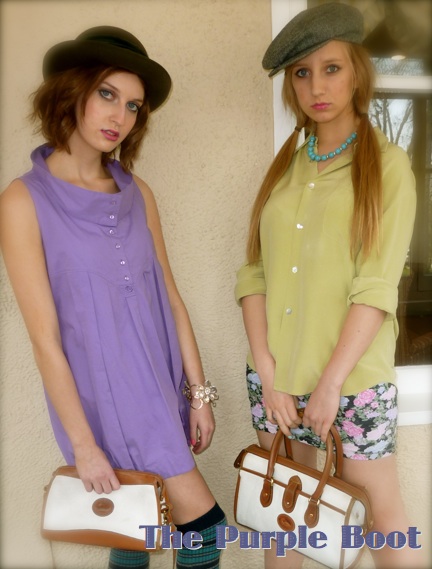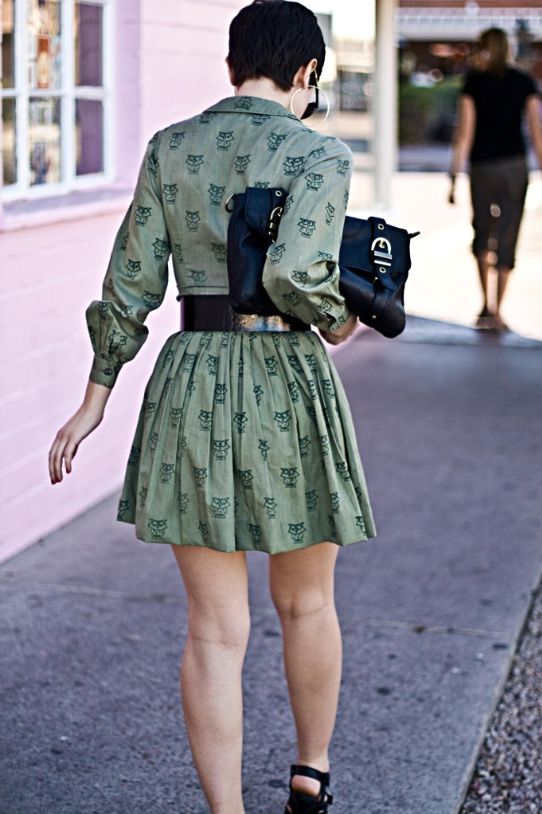Saturday, June 25, 2011
What I Wish I Was Wearing
Posted by The Purple Boot at 4:35 PM 0 comments
Labels: inspiration, Polyvore, summer
Sunday, June 19, 2011
A Little Summer Inspiration
Posted by The Purple Boot at 8:50 PM 0 comments
Labels: Chicago looks, Karla's Closet, la femme, summer
Wednesday, June 15, 2011
Sunday, June 5, 2011
How Much Is Too Much?
Jacket, Slip, Shoes, and Purse: Vintage
Dress and Head Piece: A Garbage Bag
Shirt: A Garbage Bag
Pants and Belt: Vintage
Shirt, Belt, Bag, and Necklace: Vintage
Harem Shorts: A Garbage Bag
The point of this photo shoot was to showcase innovation and to ask questions. By using a garbage bag as a piece of clothing, I hope to show that going green is just another way to be creative and to express one's self. I would also have you note the background, whether it be recycling and garbage bins, spillover of clothes, or a dirty, unkempt yard. These try to highlight the pollution plaguing our planet. But most importantly, I hope that these photos make you ask yourself: How much is too much?
Fashion is an art form; a melding together of desire, shape, and form. As Anne Hollander says in her book Sex and Suits: The Evolution of Modern Dress, “[clothes] have managed to embody these ideals in shapes that appeal to the erotic imagination, playfully combining aspiration with sex and humor, virtue with the delight of line and shape”. Fashion began as a way for people to make themselves more attractive. The French aristocracy became powerful enough to determine what was ‘in fashion’ at the beginning of the 19th century. The more clothes a person had, the more wealthy and influential they were. But rather than promote an aristocratic society, fashion helped foster democracy and equality. With the invention of department stores, people of all economic levels were allowed to shop together. Though some were not able to buy, they could “touch, even when they could not purchase”. A consumerist culture was created. According to the author of The Empire of Fashion, Gilles Lipovetsky, people became like vultures. They hovered around stores, waiting for clothes that were newer and better than ever before. They felt as if the only way they could be happy was to consume (Nussbaum). The consumer culture traveled across the Atlantic Ocean to America in the early 1900s (“History of Fashion”). Retailers in the United States began holding fashion shows, telling the American shopper what they needed to purchase next.
The world now faces the consequences of this consumer culture. The ever-changing nature of fashion forces us to believe that we must throw away “last season’s” clothes, for they are not as valuable as those of the “now.” Therefore, America creates millions of pounds of waste for fashion. Previously, every single aspect of creating clothing polluted the environment. Even textile companies would incinerate fabric samples or surplus designs so that other companies could not steal their ideas (Drake). So what is an environmentally concious person to do? You cannot stop wearing clothes, unless you decide to join a nudist colony. Thankfully, there are consumers like you, people who do not want to pollute the earth every time they get dressed. A recent study in Hong Kong found that “38 per cent of respondents ranked environmental and social issues in their top three purchasing factors” (Hills). If consumers start to demand more sustainable, Earth-friendly clothing, then companies will be forced to comply. They cannot sustain their business without someone buying their product.
Already, some businesses have begun eco-friendly practices otherwise known as practicing Green Fashion. Green Fashion simply means that companies create their products in the most environmentally friendly and sustainable way. Some examples of Green Fashion include: “eco-friendly fabrics that necessitate less energy and water or non-toxic vegetable dyes, [and] recycling previous years’ ensembles into a whole new fashion collection,” all of which were used by the students of the School of Fashion Technology (Sardesai).
The key is to be able to distinguish what is Green and what is not. Not all designers label their fabrics as recycled on the label, so it is up to you as the consumer to understand what is environmentally friendly (Valigra). Some companies claim that they use “all natural” fabrics. Silk maybe a natural fabric, but many business kill silkworms in order to produce the fabric, rather than using “ahimsa silk”: which creates silk from worms that have died naturally (Sardesai). Besides checking how natural (or not) a product is, you as the conscious shopper must understand the different ways to be Green. Some products are biodegradable, carbon neutral, or made from sustainable materials (Wilson). Biodegradable means that once the clothing is thrown away, it will not sit in a landfill but decompose in the Earth. Carbon neutral tells the consumer that the amount of energy used to create the product is not enough to harm the environment. Carbon is responsible for Green House Gases, which erode the ozone and facilitate global climate change. Since almost all industries produce carbon when producing a product, companies who are carbon neutral are very rare. Finally, sustainable fabrics are harvested from the environment as not to harm the eco-system from where it was taken.
The newest and most used Green Fashion technique is recycling plastic to make fabric. Plastic soda bottles, which are made from polyethylene terephthalate (otherwise known as PET), are now being used to make all different types of clothes, like t-shirts, sweaters, or jackets (L). This new fabric is still considered polyester, but before polyester consisted of “polyethylene and terephthlatic acid, two petroleum-based chemicals” (L). The whole process of recycling soda bottles begins at your curbside, where all the plastic is collected and brought to a facility to be sorted from your other recyclables. The plastic is then crushed into bales and sold to the companies who will use them for fabric. Once they reach these textile companies, the bottles are ground into “dirty flakes” which are squares around a ¼ inch . These flakes then get a bath in hot water with caustic chemicals to get rid of any dirt and glue. The flake is now considered clean and is melted so it can be forced through a machine similar to a showerhead to create a fiber. All the fibers are bunched together to make a “tow”, and then finally all weaved together to create the item of clothing. Though it sounds long and complicated, the whole process takes around a half hour (Valigra). The best producers of this fabric is Malden Mills Industry, who was one of the first businesses to begin recycling plastic. In 1981 Malden declared bankruptcy, since they were unable to sell their textiles. But once introducing recycled plastic fabric, they are growing at a tremendous rate and looking to expand into Europe. They sell their product to Patagonia and L.L. Bean, and as the fabric becomes more and more popular they will continue to branch out to other retailers (L). The demand for PET (or Polartec as it would say on the tag) has grown greater because according to Karen Beattie, product-marketing manager at Malden Mills, “the strength, warmth, and durability properties of virgin and recycled yarns are the same. The only difference is that recycled yarns have a matte rather than [a] glossy finish” (Valigra). Plastic is about twenty percent or sixteen million tons of America’s waste (L), so the more we are able to reuse the less trash will pollute the planet.
Green Fashion is larger then just clothing, it is also a way to help stop our consumer culture. Clothing like “The Eight”, a suit similar to a giant, transparent jellyfish tries to call attention to the ecological danger all around us and the toxins we inhale everyday ("'Eight': Fashion Forward"). Fashion has the ability to promote all different kinds of green living and can take our ideas of eco-friendly from just theories to a lifestyle. By shopping consciously you tell the industries of America that you refuse to contribute to Global Warming, that the Earth and your continued existence on it matters. Fashion is a way for you to express how you feel, and it is time for us to stop saying that we feel fine as our planet is destroyed.
Message me if you would like to see the Works Cited for further reading
Slideshow Hosted by Image Shack
Posted by The Purple Boot at 9:11 PM 0 comments
Labels: eco-friendly, garbage bag, green, IGSS
Clueless







Posted by The Cocoa Boot at 6:10 AM 0 comments













